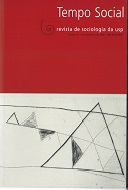Mídia, segurança pública e representações sociais
DOI:
https://doi.org/10.1590/S0103-20702009000200010Palavras-chave:
Mídia, Representações sociais, Violência policial, Segurança pública, Políticas públicas, Distrito FederalResumo
O artigo tem como objetivo pensar a natureza complexa das relações entre mídia e segurança pública, as quais, como realidades não acabadas em si mesmas, conformam um campo em constante tensão. Argumenta-se que nas modernas democracias contemporâneas a mídia se constitui em instrumento relevante de elaboração de representações sociais, que, por sua vez, para além de seu caráter falso ou verdadeiro, são veículos privilegiados para a produção e a reprodução de crenças e valores, com função pragmática enquanto orientadoras de conduta de distintos atores sociais. Defende assim a relevância de considerar que tais representações (aí incluídas, portanto, aquelas produzidas pela mídia) poderiam ser levadas em consideração, como subsídio, quando da formulação de políticas para a área da segurança pública. Como suporte empírico, o artigo se utiliza de exemplos e considerações voltados à análise do contexto do Distrito Federal.
Downloads
Referências
BOURDIEU, Pierre. (1984), Questions de sociologie. Paris, Minuit.
_____. (1996), Sur la télévision. Paris, Raisons d’Agir.
BOURDIEU, Pierre & WACQUANT, Loïc. (1992), Réponses. Paris, Seuil.
CAREY, James. (1973), “A cultural approach in communication”. Urbana-Champagn, Institute of Communications Research, University of Illinois, mimeo. (Publicado posteriormente em Communication, 2, 1975, pp. 1-22.)
_____. (1989), Communication as culture: essays on media and society. Boston, Unwin Hyman. (Reeditado em Nova York/Londres, Routledge, 1992.)
CHAMPAGNE, Patrick. (1993), “La vision médiatique”. In: BOURDIEU, Pierre (org.), La misère du monde. Paris, Seuil.
COHN, Gabriel (org.). (1987), Comunicação e indústria cultural. São Paulo, T. A. Queiróz.
COMUNICAÇÃO & POLÍTICA. (1994/1995), “Mídia, drogas e criminalidade”, v. 1, n. 2, dez./mar.
ELIAS, Norbert. (1969a), La civilisation des moeurs. Paris, Calmann-Levy.
_____. (1969b), La dynamique de l’Occident. Paris, Calmann-Levy.
GIDDENS, Antony. (2003), A constituição da sociedade. São Paulo, Martins Fontes.
JODELET, Denise. (1984), “Représentation sociale: phénomènes, concept et théorie”. In: FARR, R. M. & MOSCOVICI, S. (eds.), Social representations. Cambridge/Paris, Cambridge University Press/Maison des Sciences de l’Homme.
_____. (2001), “Representações sociais: um domínio em expansão”. In: _____ (org.), As representações sociais. Rio de Janeiro, Editora da Uerj.
JOHNSON, Richard. (2000), “O que é, afinal, estudos culturais?”. In: SILVA, Tomaz Tadeu da (org. e trad.), O que é, afinal, estudos culturais? Belo Horizonte, Autêntica.
LES CAHIERS DE LA SÉCURITÉ INTÉRIEURE. (1995), Médias e Violence. Paris, IHESI, 20 (2º trimestre).
LIMA, Venício A. de. (2001), Mídia, teoria e política. São Paulo, Editora Fundação Perseu Abramo.
MICHAUD, Yves. (1989), Violence et politique. Paris, Gallimard.
_____. (1996), La violence apprivoisée. Paris, Hachette.
MINAYO, Maria Cecília de Souza. (1994), “O conceito de representações sociais dentro da sociologia clássica”. In: JOVCHELOVITCH, S. & GUARESCHI, P. (orgs.), Textos em representações sociais. Petrópolis, Vozes.
MOSCOVICI, Serge. (1984), “The phenomenon of social representations”. In: FARR, R. M. & MOSCOVICI, S. (orgs.), Social representations. Cambridge/Paris, Cambridge University Press/Maison des Sciences de l’Homme.
_____. (1989), “Des représentations collectives aux représentations sociales: éléments pour une histoire”. In: JODELET, D. (org.), Les représentations sociales. Paris, Presses Universitaires de France.
_____. (1994), “Prefácio”. In: JOVCHELOVITCH, S. & GUARESCHI, P. (orgs.), Textos em representações sociais. Petrópolis, Vozes.
_____. (2003), Representações sociais, investigações em Psicologia Social. Petrópolis, Vozes.
MUHLMANN, Géraldine. (2008), “Presse et démocracie”. In: PARK, Robert E. et al. (orgs.), Le journaliste et le sociologue. Paris, Seuil.
PERALVA, A. & MACÉ, E. (2002), Médias et violences urbaines: débats politiques et construction journalistique. Paris, IHESI, La Documentation Française.
PORTO, Maria Stela Grossi. (1989), “A produção ideológica como produção material”. In: FIGUEIREDO, Vilma (coord.), Estado, sociedade e tecnologia agropecuária. Brasília, Editora Pax.
_____. (2001a), “Violência e segurança: a morte como poder?”. In: OLIVEIRA, Dijacy de et al. (orgs.), Violência policial: tolerância zero? Brasília/Goiânia, MNDH/UFG.
_____. (2001b), “Impunidade, avesso da reciprocidade”. Sociedade e Estado, 16 (1/2): 336-349, jan./dez.
_____. (2002), “Violência e meios de comunicação de massa na sociedade contemporânea”. Revista Sociologias, Porto Alegre, 4 (8): 152-171, jul./dez.
_____. (2004), “Polícia e violência: representações sociais de elites policiais do Distrito Federal”. São Paulo em Perspectiva. Fundação Seade. São Paulo, 18 (1): 132-141, jan./mar.
PROULX, Serge. (1995), “Les perspectives d’analyse des médias: des effets aux usages”. Les Cahiers de la Sécurité Antérieure, Paris, IHESI, 20 (2º trimestre).
REVISTA DA USP. (1991), “Dossiê violência”, São Paulo, mar./abr./maio.
RAMOS, Silvia & PAIVA, Anabela. (2007), Mídia e violência: novas tendências na cobertura de criminalidade e segurança no Brasil. Rio de Janeiro, Iuperj.
TOURAINE, Alain. (1997), “Faux et vrais problèmes”. In: WIEVIORKA, M. (org.), Une societé fragmentée? Le multiculturalisme en débat. Paris, La Decouverte/Poche.
WIEVIORKA, Michel. (2006), Em que mundo viveremos? São Paulo, Perspectiva.
_____. (2005), La violence. Paris, Pluriel Hachette Litterátures.
_____. (2002), La diférence, identités culturelles: enjeux, débats et politiques. Paris, Éditions de l’Aube.
_____. (1997), “O novo paradigma da violência”. Tempo Social, São Paulo, 9 (1): 5-42, maio.
WOLF, Mauro. (1987), Teorias da comunicação. Lisboa, Presença.
WOLTON, Dominique. (2004), Pensar a comunicação. Brasília, Editora UnB.
Downloads
Publicado
Edição
Seção
Licença
Copyright (c) 2015 Tempo Social

Este trabalho está licenciado sob uma licença Creative Commons Attribution-NonCommercial 4.0 International License.



